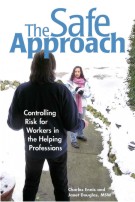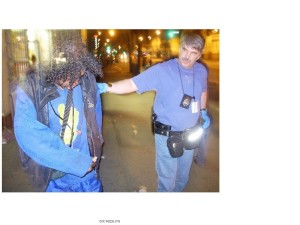I spent many years in the Mental Health Emergency Services unit of VPD getting mentally ill people safely to treatment facilities. For nine years I managed to do this without ever harming a client, at the same time always keeping the nurses and social workers that I worked with out of harm’s way. Now I’d like to share some of my experience with social workers and nurses to keep them safe in the field.
Before you leave the office, always start by reviewing all available collateral information on the person you intend to assess. This should include police history (criminal record, call history) as well as mental health/hospital records (history of treatment, behaviour when ill). Try to identify patterns and “baseline” behaviour. Do they have common delusions such as the idea that someone is projecting energy/radio waves into them? Maybe they’re paranoid? Look for precautions that they may have taken to “protect” themselves from these perceived threats. Those countermeasures may constitute a threat to your safety.
Always be looking for obvious signs of use of prescription or non-prescription drugs, as well as the use of alcohol or street drugs. Many mentally ill people attempt to self medicate. Many psychiatric meds should not be mixed with alcohol consumption. Many of these attempts to self medicate only exacerbate their illness. If you can, get the person to show you their meds. This will give you an idea what it is they are taking, as well as how much. If the label on the bottle containing a month’s supply of pills is dated the beginning of the month and it is now the end of the month with the bottle nearly full, it is a clear indication that they aren’t compliant with their medications. The label on the medications also will give you an idea who the GP or psychiatrist of record is.
If the client admits that they’ve discontinued meds, try to find out why. Many medications have side effects which cause the patient to give up on them, such as drowsiness or weight gain. Ask if they’ve had allergic reactions. Often they’ll give you accurate information on allergies. Many patients with a history of non-compliance will respond to my question about allergies by listing every psychiatric medication they’ve ever been prescribed. This is a pretty clear indication that they aren’t going to cooperate with the medical plan without supervision.
Many emotionally disturbed people can pull it together for a short time in an attempt to cover their illness and avoid apprehension. A little patience and persistence can often pay off as most of them cannot maintain this front for long. It is a bit like asking them not to blink. Sooner or later it will out.
I’ve always found it useful to ride in the ambulance and/or continue the assessment at the hospital. Typically as soon as the client realizes that “the game is up”, they will drop their guard and let out all kinds of useful information and behaviours. All this information should be carefully documented to assist people trying to follow up later.
Be direct. Ask the client up front if they are suicidal, or having thoughts of harming themselves or others. It is amazing how many social workers and police officers find this question so difficult to ask. Remember, you’re there to help them and this information is vital. Ask them if the client feels safe. Do they feel a need to protect themselves? If so, what measures have they taken to protect themselves? This will give you an idea if they are paranoid and, if so, how severe the paranoia is. It also alerts you to dangerous behaviours and situations to guard against.
Ask if the client hears voices. If so, are these “voices” telling the client to do certain things (command hallucinations)? Does the client believe that they are getting messages from the TV, radio, or newspaper? Ask if the client believes that they can read your thoughts and/or if they think that you can read theirs. Watch for blocking behaviour and/or latency of response. If they take their time responding to you, they may be responding to internal stimuli. Do they appear to be looking at things or responding to stimuli no one else perceives?
Safety is an ongoing reassessment of your surroundings and the persons that you are in contact with. If you pay attention to the things I’ve listed here, you’ll be in good shape to keep yourself and your client safe.
Charles Ennis
Filed under: Uncategorized | Tagged: contingencies, mental illness, planning |




[…] Anxiety Insights wrote an interesting post today onHere’s a quick excerptI spent many years in the Mental Health Emergency Services unit of VPD getting mentally ill people safely to treatment facilities. I managed to do this for nine years without ever harming a client, at the same time always keeping the nurses and social workers that I worked with out of harm’s way. I’d like to share some of my experience with social workers and nurses to keep them safe in the field. Before you leave the office, always start by reviewing all available collateral information on the person you intend to assess. This should include police history (criminal record, call history) as well as mental health/hospital records (history of treatment, behaviour when ill). Try to identify patterns and “baseline” behaviour. Do they have common delusions such as the idea that someone is projecting energy/radio waves into them? Maybe they’re paranoid? Look for precautions that they may have taken to “protect” […] […]
I found your site on technorati and read a few of your other posts. Keep up the good work. I just added your RSS feed to my Google News Reader. Looking forward to reading more from you down the road!
Tell me this,
You will see on my link that there is a very dangerous woman who is loose in our town who has severe mental illness. She has jumped people, stabbed people, threatened her mother, but she still manages to sneak by the cops and denies treatment.
Right now she is homeless and could be anywhere hiding out, ready to pick fights with people.
I have posted as many flyers, video warnings, what else can I do? The cops can’t do anything.
I’m surprised to hear that, Frank. Most police agencies these days work closely with local mental health authorities to deal with such issues, because they have come to realize that dealing with such mental health issues greatly reduces the crime rates. The MHES unit that I used to work for went out several times a year with professionals from several agencies to locate and assess homeless people to get those who needed treatment and housing the services that they needed. Have you contacted your local mental health authorities to see if they are aware of the problem? If they can get this person certified it will make the job that the police have in this case much easier.
I’ve put an article discussing police response systems on the blog today as a result of your comment. Thanks for giving me the idea.
Charles Ennis
I LIVE NEXT DOOR TO A EDP NEIGHBOR AND ON WEDNESDAY, WE BITH GOT INTO A VERBAL ALMOST PHYSICAL ATTACK REGARDING SHE TALKING IN A VERY WRONG WAY TO MY NIECE, WHICH SHE TREATEND ME AND I CALLED THE POLICE. NOT UNTIL TODAY I LEARNED SHE DISTURBED, I KNEW SHE HAD A MENATL ILLNESS BUT ALSO SHE HAS A HISTORY OF DRUG ABUSE AND SHE AHS 2 CHILDREN LIVING WITH HER. ALSO SHE HAS MANY GANG RELATED PEOPLE VISITING HER AT ALL TIMES OF THE DAY OR NIGHT.WHAT CAN I DO OR WHO CAN I CONTACT WITH THIS PROBLEM?
You need to keep in touch with the police and be their “eyes and ears” to monitor this situation. You should also be in contact with local mental health and child welfare authorties (the local police can give you the contact numbers).
Regards, Charles